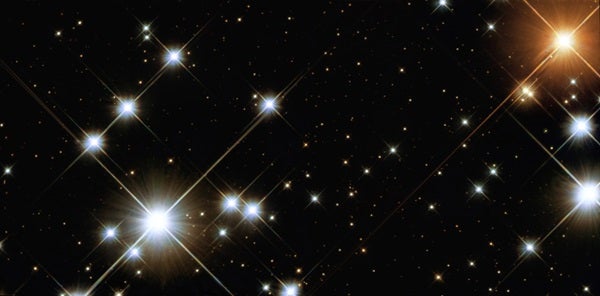The combination of images taken by three exceptional telescopes — the NASA/European Space Agency (ESA) Hubble Space Telescope, the European Southern Observatory (ESO) Very Large Telescope on Cerro Paranal, and the MPG/ESO 2.2-meter telescope at ESO’s La Silla Observatory — has allowed the stunning Jewel Box star cluster to be seen in a whole new light.
Star clusters are among the most visually alluring and astrophysically fascinating objects in the sky. One of the most spectacular of these objects nestles deep in the southern skies near the Southern Cross in the constellation Crux.
The Kappa Crucis Cluster, also known as NGC 4755 or simply the Jewel Box, is just bright enough to be seen with the unaided eye. It was given its nickname by the English astronomer John Herschel in the 1830s because the striking color contrasts of its pale blue and orange stars seen through a telescope reminded Herschel of a piece of exotic jewelry.
Open clusters such as NGC 4755 typically contain anything from a few to thousands of stars that are loosely bound together by gravity. Because the stars all formed together from the same cloud of gas and dust, their ages and chemical makeup are similar, which makes them ideal laboratories for studying how stars evolve.
The position of the cluster amongst the rich star fields and dust clouds of the southern Milky Way is shown in the wide field view generated from Digitized Sky Survey 2 data. This image also includes one of the stars of the Southern Cross as well as part of the huge dark cloud of the Coal Sack.
The Jewel Box may be visually colorful in images taken on Earth, but observing from space allows the NASA/ESA Hubble Space Telescope to capture light of shorter wavelengths than can be seen by telescopes on the ground. This new Hubble image of the core of the cluster represents the first comprehensive far ultraviolet to near-infrared image of an open galactic cluster. It was created from images taken through seven filters, allowing viewers to see details never seen before. It was taken near the end of the long life of the Wide Field Planetary Camera 2 — Hubble’s workhorse camera up until the recent servicing mission when it was removed and brought back to Earth. Several very bright, pale blue supergiant stars, a solitary ruby-red supergiant, and a variety of other brilliantly colored stars are visible in the Hubble image, as well as many fainter ones. The intriguing colors of many of the stars result from their differing intensities at different ultraviolet wavelengths.
Another new image taken with the Wide Field Imager (WFI) on the MPG/ESO 2.2-meter telescope at ESO’s La Silla Observatory shows the cluster and its rich surroundings in all their multicolored glory. The large field of view of the WFI shows a vast number of stars. Many are located behind the dusty clouds of the Milky Way and therefore appear red. The FORS1 instrument on the ESO Very Large Telescope (VLT) allows a closer look at the cluster itself. The telescope’s huge mirror and exquisite image quality have resulted in a new, sharp view despite a total exposure time of just 5 seconds. This new image is one of the best ever taken of this cluster from the ground.
The variety in brightness of the stars in the cluster exists because the brighter stars are 15 to 20 times the mass of the Sun, while the dimmest stars in the Hubble image are less than half the mass of the Sun. More massive stars shine much more brilliantly. They also age faster and make the transition to giant stars more quickly than their faint, less-massive siblings.
The Jewel Box cluster is about 6,400 light-years away, and it is approximately 16 million years old.











